Project Log: Sunday, November 27, 2011
After several weeks away from the project, between
houseguests, vacation, and Thanksgiving, I was looking
forward to a full day of work. As it happened, I
was disappointed in my progress for the day, with other
distractions affecting my focus, but in any event it was
a critical day to reacquaint myself with the project and
prevent momentum from spiraling downwards.
I realized I couldn't do too much additional layout on
the new pilothouse bulkheads until I received some
critical parts for the heating system and engine, namely
the two expansion tanks required for these systems.
Both of these tanks would have to be installed somewhere
behind the new bulkheads in order to ensure that the
tanks were the high points in their respective systems,
and I'd need access hatches in the appropriate areas,
but I didn't know the dimensions of the tanks, so that
would have to wait. It had been about eight weeks
since I ordered the engine, so I expected its delivery
pretty much anytime; the heating system had been delayed
in shipment, but I expected it in the coming few days.
I did complete some additional preliminary layout,
striking a few level reference lines on each side.
I also used the side panel from the original helm
console to make additional reference lines, though my
new console might be differently shaped depending on how
I chose to lay things out. Critical to the console
layout were the choices I was making for electronics,
which I planned to build in to the design, so I was
pursuing that avenue as time allowed, and was nearly
ready to commit and purchase the electronics suite.
Finally, the layout of this area also depended on my
electrical service panel, which I planned to install
either in the bottom portion of the helm console or in
the port pilothouse bulkhead. So I'd started
working out my electrical system needs so I could begin
to pursue a custom panel, the size of which might
dictate its location and/or the construction of the helm
console. As always, one decision or layout hinged
upon one or more others, but the various pieces would
soon fall into place. |
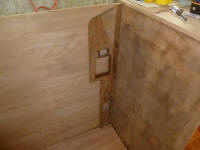 |
As part of the pilothouse panel layout, I decided to
install the fuel and water tank fill/vent fittings in
the molded recesses I'd built some time earlier.
There was no particular need to do this now, but I had
to install the fills sometime, and since I was working
in the area and had no other clear direction as I tried
to get re-involved, it seemed a perfect day to complete
this task.
There were five fill/vent fittings to install:
three for fuel, and two for water, to service all the
tanks in the engine room. The fill for the final
water tank, in the forward cabin, would be located
somewhere on the foredeck, and I'd deal with that later.
Each fitting required a roughly keyhole-shaped hole for
installation, which I made with two hole saws as needed
after using the supplied template to mark each location.
I protected the painted surface of the recesses with
tape. Once the large holes were ready, I inserted
each fitting and drilled and tapped the four screw holes
for pan head machine screws to hold the fills in place. |
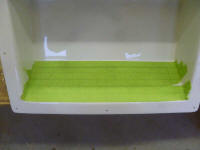
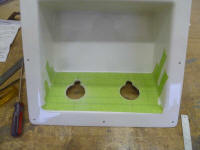
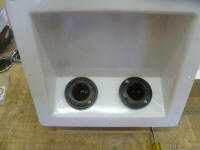 |
The fittings were nylon or plastic of some sort, so to
permanently install them I chose butyl sealant, since I
wasn't sure if polysulfide was compatible with the
plastic, and I avoid silicone at all costs. As
always, the butyl was messy to install, and I got fed up
after installing two fittings in the starboard recess,
so I called it a day once I'd cleaned up the excess
sealant there; I'd finish the final installation on the
port recess in the near future. |
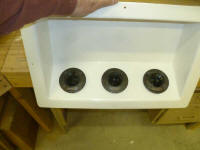
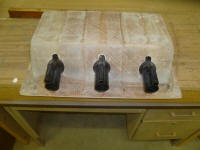 |
I liked these fittings, despite their plastic
construction, which I'd normally avoid in favor of
metal. But the integral vent seemed like a
convenient idea for my installation, since it would
minimize hose runs; in addition, the vent fitting opened
into the fill pipe itself, theoretically directing
vented fuel back into the tank instead of overboard. I
also liked the caps that didn't require keys to open.
Time would tell how these fittings worked in practice. |
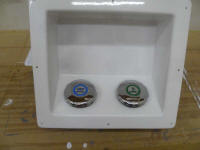
|
Total Time Today: 3 hours
|
<
Previous |
Next > |
|
|








